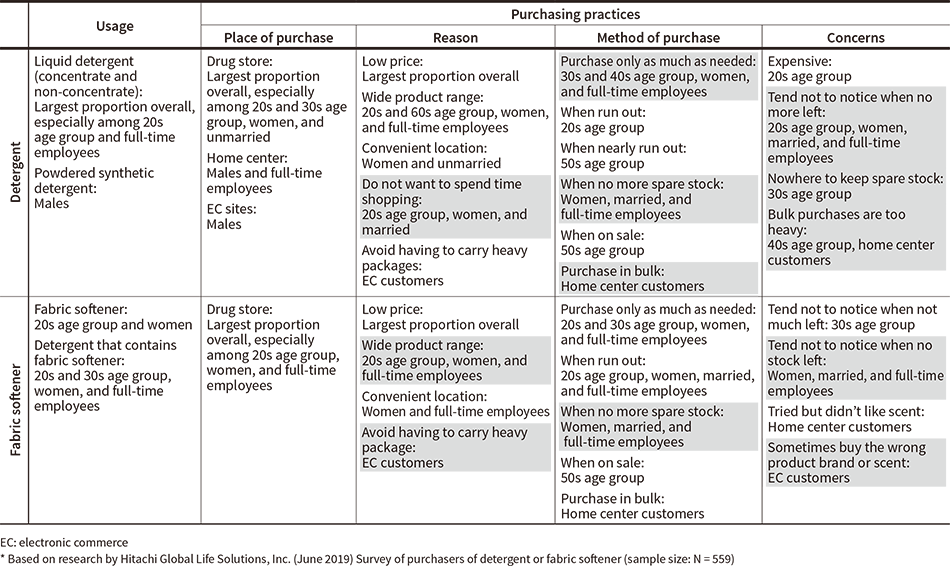Enhancing QoL by Meeting Needs of Increasingly Diverse Lifestyles
Having set out to deliver “products and services that meet individual needs” in response to increasingly diverse consumer needs, Hitachi Global Life Solutions, Inc. is seeking to improve the QoL of people around the world. By utilizing connected appliances and their capacity for software updates, the company intends not only to keep up with changes in the lifestyle challenges and structure of society on the product front, but also to supply solutions through interoperation with the products and services of partners inside and outside Hitachi. This article describes a service for automatically reordering detergent and fabric softener for connected washer dryers that is intended to improve consumer QoL by incorporating vision-driven development as well as traditional development practices, and how this service is being implemented through integration with an Amazon system.




Lifestyle services encompassing things like sharing, delivery, and communication tools have seen rapid growth over recent years against a background of advances in digital technology, bringing with them greater diversity in how people live and perceive value. This trend is evident not only in developed countries, but also in emerging economies. In Japan, too, the emergence of these digital lifestyle services is being accompanied by changes in the structure of society, including a rising number of small or single-person households, a low birthrate, and an aging population, creating greater diversity in how people live.
In response to this growing lifestyle diversity, Hitachi Global Life Solutions, Inc. (Hitachi GLS) is seeking to improve the quality of life (QoL) of people everywhere by conducting market research that includes surveys of living practices and consumer needs and receptivity to identify their dissatisfactions, preferences, and hidden needs so that it can supply “products and services that meet individual needs.” By taking advantage of digital technology, connected appliances offer the convenience of being able to be enhanced by means of software updates. As well as satisfying these diverse requirements, these connected appliances can also help make life more convenient and comfortable by adapting to people’s changing circumstances across different life stages. By collecting and analyzing information about people’s needs and concerns in different areas of life, Hitachi GLS can go beyond the conventional practice of delivering standalone products and instead use connected appliances as a basis for also offering services and solutions that work in tandem with the products and services of partners inside and outside Hitachi.
This article describes an example of such a service for washer dryers with connected appliance functionality.
In Japan, greater lifestyle diversity and changes in the structure of society that include an increasing number of dual-income households and a rising elderly population mean that this diversity extends to consumer needs for home appliances and lifestyle services. In the case of laundry, the rising number of dual-income and single-person households is driving demand for being able to wash a large amount of clothes in a single load and to be able to do it more quickly and with less bother. The rising number of elderly households and households where partners share the housework, on the other hand, is bringing greater demand for simplicity and labor saving as people want appliances that are easy to use (see Figure 1).
Hitachi washer dryers offer a variety of solutions that address these challenges, including an “auto dosing system of detergent and fabric softener” that automatically dispenses detergent and fabric softener for each wash; an AI Wash function that uses artificial intelligence (AI) to select the wash cycle and time automatically, cleverly delivering a clean wash without the user having to specify detailed settings; and the Wind Iron function that reduces the need for ironing by blowing high-velocity air that smooths out wrinkles as it dries the clothes. These functions are seen by consumers as important features when making a purchase (see Figure 2).
Figure 3 — Connected Appliances
 Use of the Hitachi washer app in tandem with the washer dryer makes laundry more convenient.
Use of the Hitachi washer app in tandem with the washer dryer makes laundry more convenient.
Hitachi’s BD-NX120E and BD-SX110E front-loading washer dryers and BW-DX120E top-loading washer dryer are all connected appliances and come with a Hitachi washer app as well as the auto dosing system of detergent and fabric softener, AI Wash, and Wind Iron (front-loading machine only) features.
In addition to a concierge function that supports users with laundry advice based on weather reports or by recommending which cycle to use based on fabric type or other circumstances, the app also allows users to customize the operation of the appliance to their personal preferences, including a personalized AI wash cycle that learns how to wash in accordance with user preferences and additional wash cycle options available for downloading. Approximately 18,000 machines had been connected to the Internet by the end of August 2020, roughly 11 months after the connected washer dryers (the BD-NX120E, BD-SX110E, and BW-DX120E) first went on sale (see Figure 3).
Table 1 — Consumer Survey of Detergent and Fabric Softener
 The survey results indicate consumer concerns as well as differences in place of purchase and what factors are important for detergent and fabric softener.
The survey results indicate consumer concerns as well as differences in place of purchase and what factors are important for detergent and fabric softener.
Hitachi has also conducted a survey on detergent and fabric softener, products that are closely related to laundry in terms of their role in routine housework. Conducted online, the survey covered a wide range of consumers in the 20s to 60s age brackets, asking them about their choice of detergent, where and how they purchase it, and any concerns they have. The results found that most users chose liquid detergent and that they tend to purchase it at drug stores (household goods retailers). In terms of their reasons, the responses revealed different attitudes about what was important in the purchasing experience. Low price and convenience of location were among the reasons given for purchasing from drug stores, whereas those respondents who purchased via electronic commerce (EC) indicated that they did so because they did not want to spend time shopping and because it avoided the need to carry home heavy items. With regard to purchase timing, while many respondents said they did so when their stock of detergent ran low, concerns were also expressed about how the amount of detergent remaining was difficult to judge (see Table 1).
Figure 4 — Vision-driven Product Development
 Product and service development is facilitated by identifying kizashi (signs) as to how people will perceive value in the future, and then using this to “backcast” to the present day.
Product and service development is facilitated by identifying kizashi (signs) as to how people will perceive value in the future, and then using this to “backcast” to the present day.
Along with the traditional forecasting methods used in product development, Hitachi GLS also utilizes a vision-driven approach to the development of products and services that looks at changing attitudes and how people will live in the future to identify kizashi (signs) as to how people will perceive value in the future, and then uses this to “backcast” to the present day. One such kizashi that points to the future for consumers is “housework refactoring,” meaning the reorganizing of housework into small tasks. Given the anticipated rise in the number of households made up of elderly people only, this predicts that there will be a need to reduce the amount of work involved in household tasks such as cooking, laundry, and cleaning as well as the purchase of food and other daily necessities so that they can enjoy secure and independent lives, while on the other hand households where both partners are busy working and who also need to fit in time for childcare or in some cases caring for the elderly will likewise need time-saving and other such measures that make housework easier. Another kizashi, “IT enriches senior life,” recognizes that IT can be a lifeline for the elderly but that, as the population increasingly ages, the digital divide between those people who are and those who are not familiar with information and communications technology such as personal computers and the Internet may also lead to different outcomes in terms of QoL (see Figure 4).
Along with the kizashi of “housework refactoring” and “IT enriches senior life,” it was the consideration of the above challenges posed by laundry that prompted the idea of a service that utilizes digital technology to link to EC and automate the task of purchasing detergent and fabric softener for doing the washing. The service offers convenience by delivering these products when needed, freeing consumers from having to carry home heavy packages in order to get the washing done, and taking over the task of ordering to make sure that detergent and fabric softener never runs out. This has the potential to improve the QoL of a wide range of people, from the elderly who find shopping difficult to working couples who are pressed for time.
The system for automatically reordering detergent and fabric softener works by, (1) measuring detergent and fabric softener usage and tracking how much is left, and (2) placing an order on an EC site when stocks run low.
These two functions were developed and used to implement a system for automatically reordering detergent and fabric softener (see Figure 5).
Figure 5 — System for Automatically Reordering Detergent and Fabric Softener
 The system for automatically reordering detergent and fabric softener was implemented by developing an algorithm for tracking how much detergent and fabric softener is left and ordering more when needed.
The system for automatically reordering detergent and fabric softener was implemented by developing an algorithm for tracking how much detergent and fabric softener is left and ordering more when needed.
Figure 6 — Service Implemented through Integration with Amazon Dash Replenishment
 The service for automatically reordering detergent and fabric softener is designed to work with Amazon Dash Replenishment and was launched in December 2019.
The service for automatically reordering detergent and fabric softener is designed to work with Amazon Dash Replenishment and was launched in December 2019.
To perform automatic reordering using this new system, Hitachi GLS launched a service for automatically reordering detergent and fabric softener in December 2019 that works with Amazon Dash Replenishment*, an EC service run by Amazon.com, Inc. that stocks these products. Thanks to software updates, the reordering service is available to all owners of compatible appliances, including those purchased before the service launch (see Figure 6).
As with the service for automatically reordering detergent and fabric softener described above, connected appliances can be enhanced by means of software updates. Based on customer feedback regarding the December 2019 service for automatically reordering detergent and fabric softener, Hitachi developed a function to help users with purchasing that works by notifying users when levels run low and assists them in purchasing more from an EC site. The function was rolled out as a software update and commenced service in March 2020, increasing customer choice by assisting with the purchasing of detergent and fabric softener. Hitachi intends to continue with other such initiatives that seek to address a variety of lifestyle and societal challenges through post-purchase updates to washer dryers, including offering new wash cycles.
Figure 7 — Log Data from Connected Appliances
 The objective is to determine how home appliances are used in practice by analyzing data on their operation.
The objective is to determine how home appliances are used in practice by analyzing data on their operation.
This article has presented an example of how Hitachi GLS is seeking to improve consumer QoL by using washer dryers as connected appliances. While this example involves service development by means of situation analysis and vision-driven development, the contact people have with connected appliances in their daily lives means these devices are also able to collect data on how people live (see Figure 7).
The ability of such data collected from connected appliances to provide timely information on how people really live offers immense possibilities and Hitachi believes it can help find solutions to a variety of lifestyle and societal challenges. By analyzing this lifestyle data and combining it with various other products and services, Hitachi intends to supply new smart life solutions and work toward the achievement of a higher QoL.